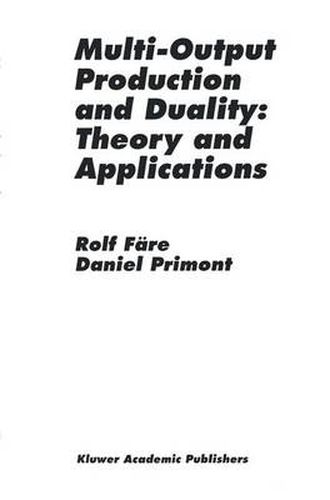Readings Newsletter
Become a Readings Member to make your shopping experience even easier.
Sign in or sign up for free!
You’re not far away from qualifying for FREE standard shipping within Australia
You’ve qualified for FREE standard shipping within Australia
The cart is loading…






This title is printed to order. This book may have been self-published. If so, we cannot guarantee the quality of the content. In the main most books will have gone through the editing process however some may not. We therefore suggest that you be aware of this before ordering this book. If in doubt check either the author or publisher’s details as we are unable to accept any returns unless they are faulty. Please contact us if you have any questions.
Our original reason for writing this book was the desire to write down in one place a complete summary of the major results in du ality theory pioneered by Ronald W. Shephard in three of his books, Cost and Production Functions (1953), Theory of Cost and Produc tion Functions (1970), and Indirect Production Functions (1974). In this way, newcomers to the field would have easy access to these important ideas. In adg,ition, we report a few new results of our own. In particular, we show the duality relationship between the profit function and the eight equivalent representations of technol ogy that were elucidated by Shephard. However, in planning the book and discussing it with colleagues it became evident that such a book would be more useful if it also provided a number of applications of Shephard’s duality theory to economic problems. Thus, we have also attempted to present exam ples of the use of duality theory in areas such as efficiency measure ment, index number theory, shadow pricing, cost-benefit analysis, and econometric estimation. Much of our thinking about duality theory and its uses has been influenced by our present and former collaborators. They include Charles Blackorby, Shawna Grosskopf, Knox Lovell, Robert Russell, and, not surprisingly, Ronald W. Shephard. We have also benefit ted over the years from many discussions with W. Erwin Diewert.
$9.00 standard shipping within Australia
FREE standard shipping within Australia for orders over $100.00
Express & International shipping calculated at checkout
This title is printed to order. This book may have been self-published. If so, we cannot guarantee the quality of the content. In the main most books will have gone through the editing process however some may not. We therefore suggest that you be aware of this before ordering this book. If in doubt check either the author or publisher’s details as we are unable to accept any returns unless they are faulty. Please contact us if you have any questions.
Our original reason for writing this book was the desire to write down in one place a complete summary of the major results in du ality theory pioneered by Ronald W. Shephard in three of his books, Cost and Production Functions (1953), Theory of Cost and Produc tion Functions (1970), and Indirect Production Functions (1974). In this way, newcomers to the field would have easy access to these important ideas. In adg,ition, we report a few new results of our own. In particular, we show the duality relationship between the profit function and the eight equivalent representations of technol ogy that were elucidated by Shephard. However, in planning the book and discussing it with colleagues it became evident that such a book would be more useful if it also provided a number of applications of Shephard’s duality theory to economic problems. Thus, we have also attempted to present exam ples of the use of duality theory in areas such as efficiency measure ment, index number theory, shadow pricing, cost-benefit analysis, and econometric estimation. Much of our thinking about duality theory and its uses has been influenced by our present and former collaborators. They include Charles Blackorby, Shawna Grosskopf, Knox Lovell, Robert Russell, and, not surprisingly, Ronald W. Shephard. We have also benefit ted over the years from many discussions with W. Erwin Diewert.